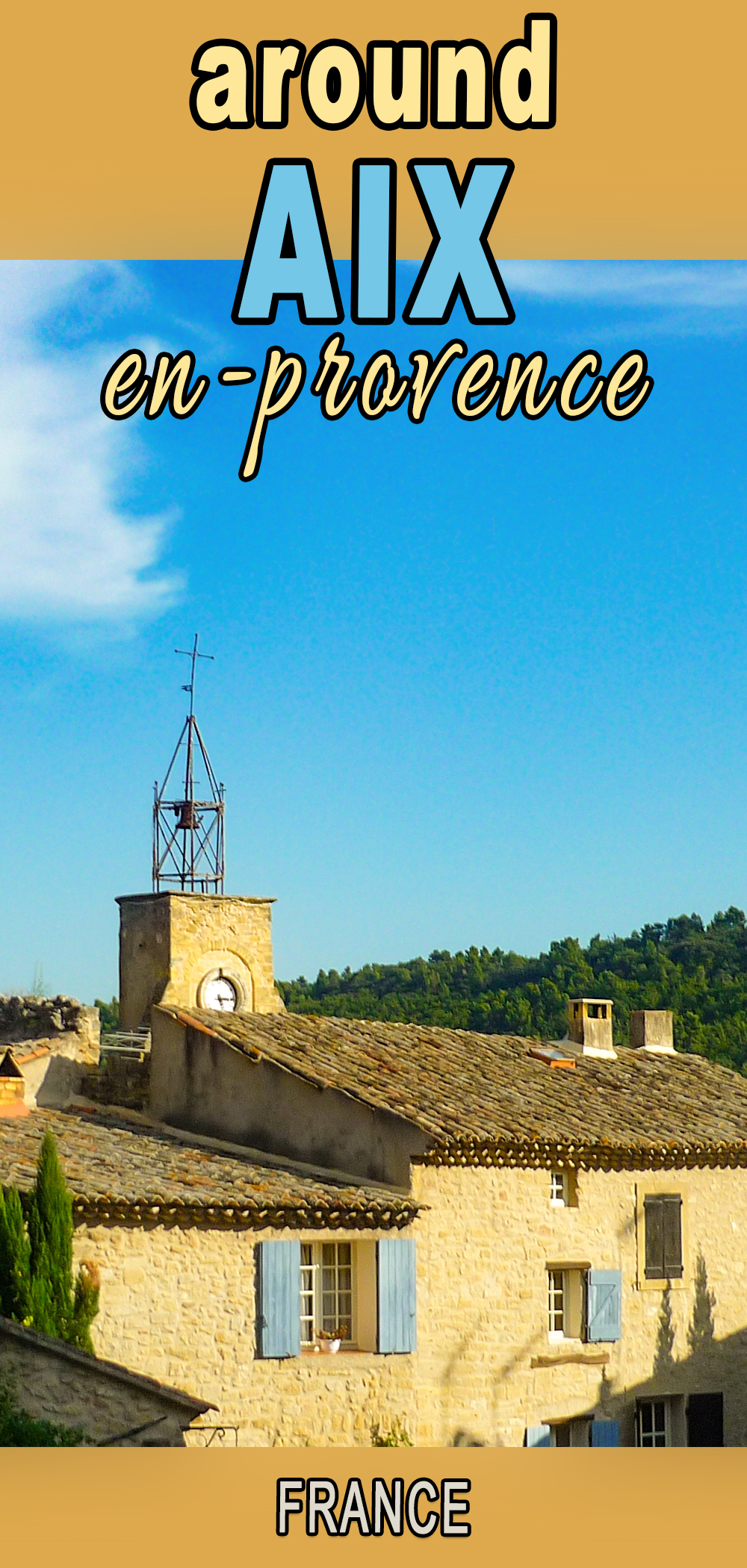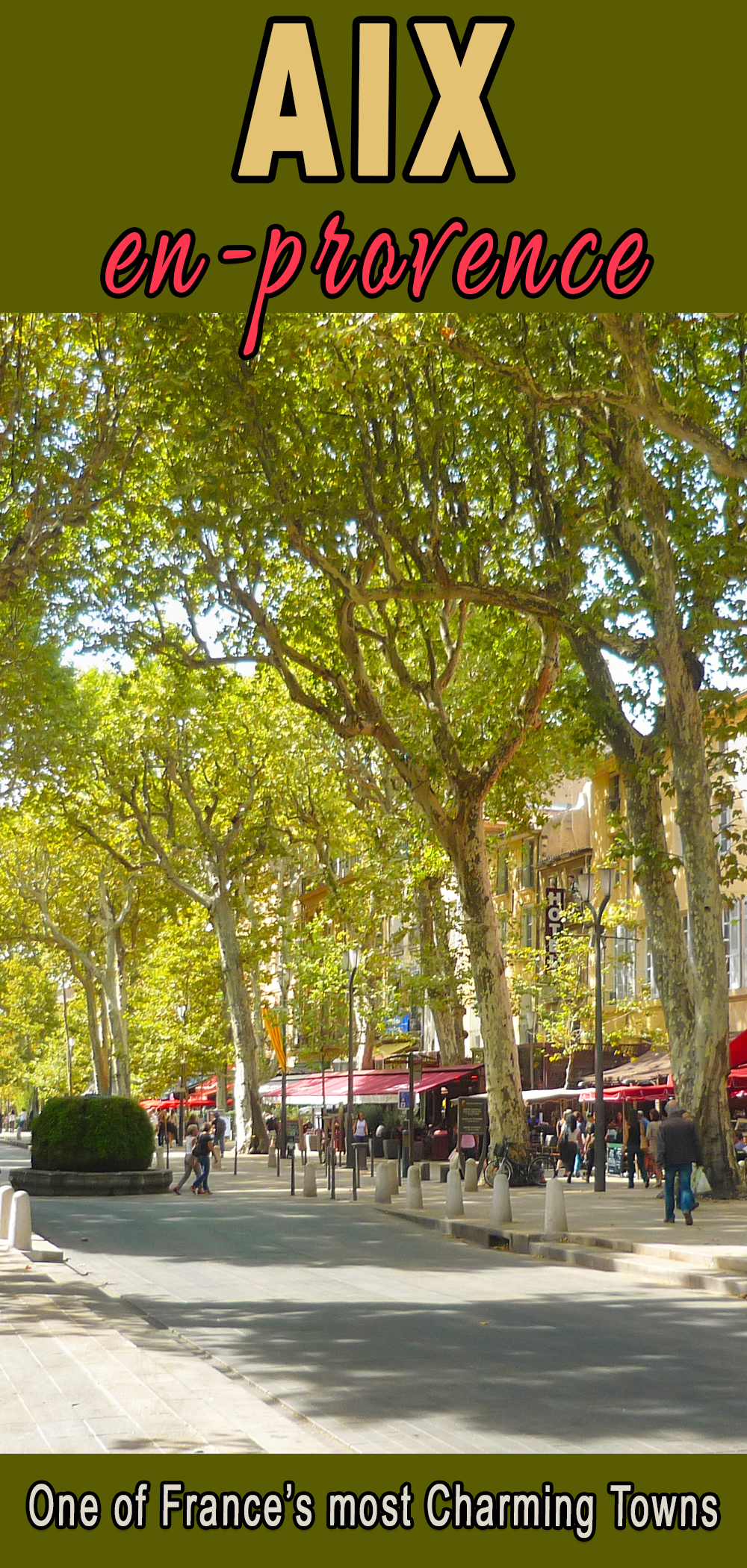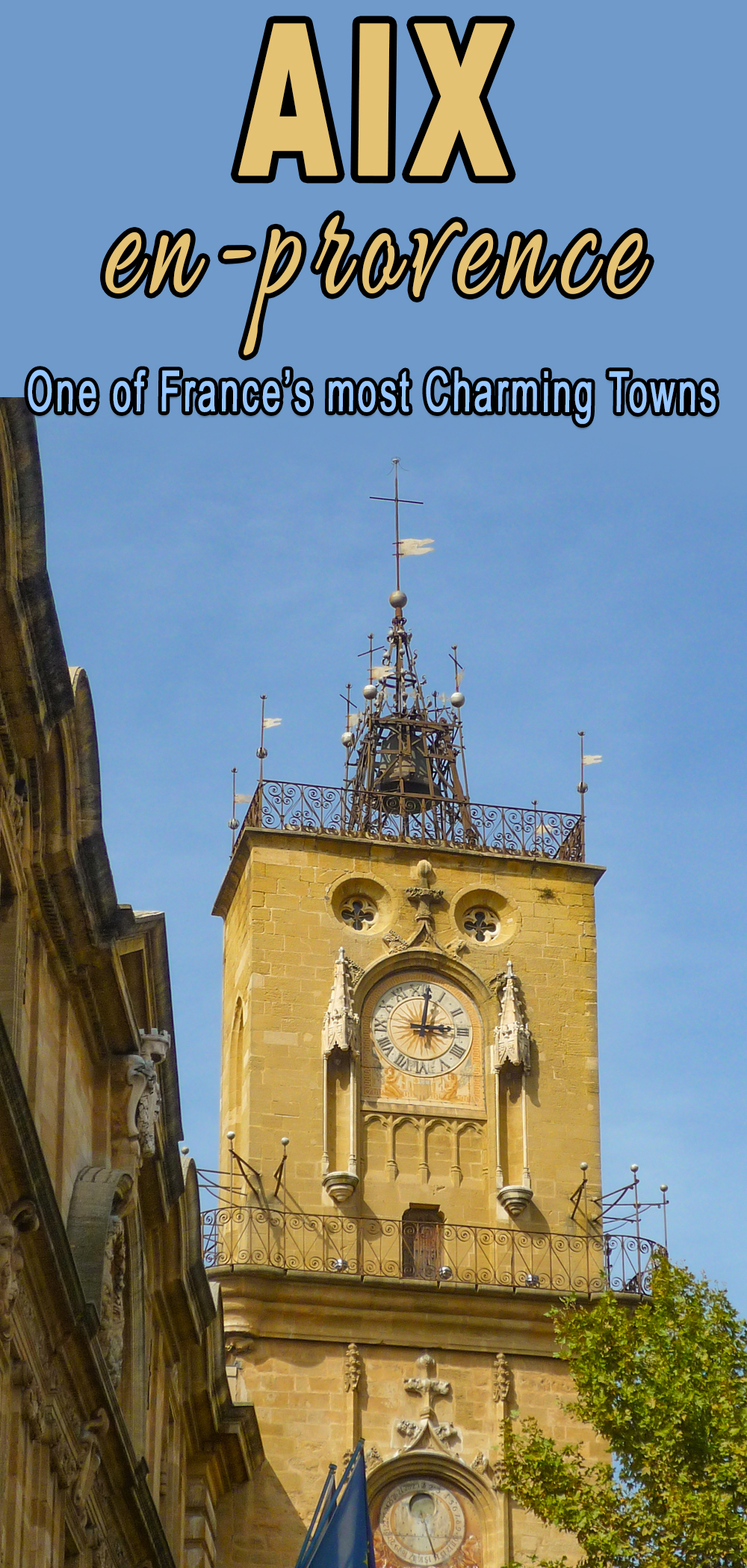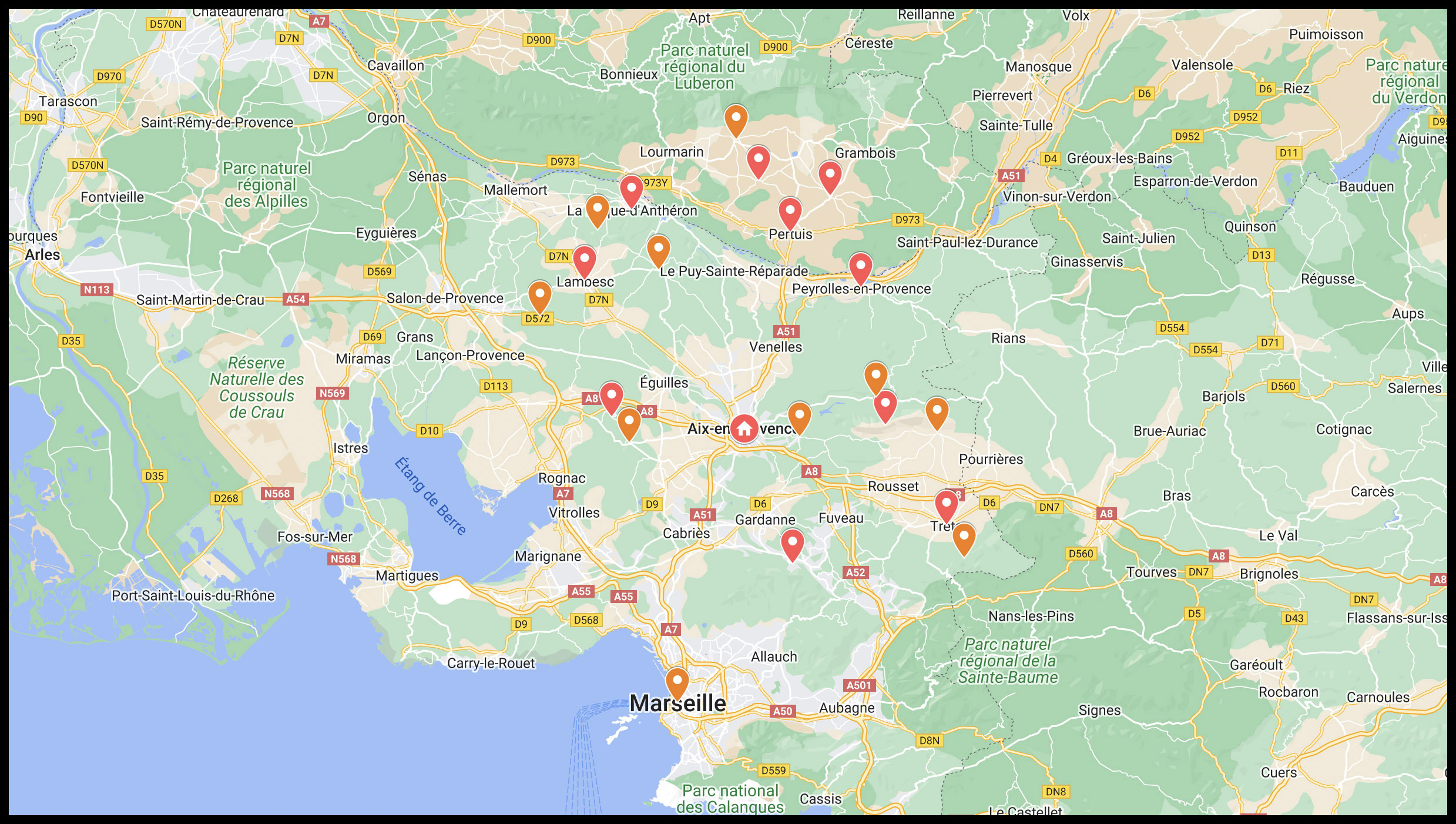Is there any need to introduce Aix, the historical capital of Provence? The charming town offers visitors a rich and fascinating architectural and cultural heritage. But beyond the homeland of Paul Cézanne and Emile Zola, there are many sites to explore. The Pays d’Aix, of course, but also natural sites, beautiful ruins, and typical Provençal localities on the border with the neighbouring département of Vaucluse. What are the ten places to see in the region around Aix-en-Provence? Follow the guide and let’s go on an excursion less than 30 km from the centre of Aix!
Around Aix-en-Provence
What does Aix-en-Provence mean to you?
The Cours Mirabeau and its mossy fountains?
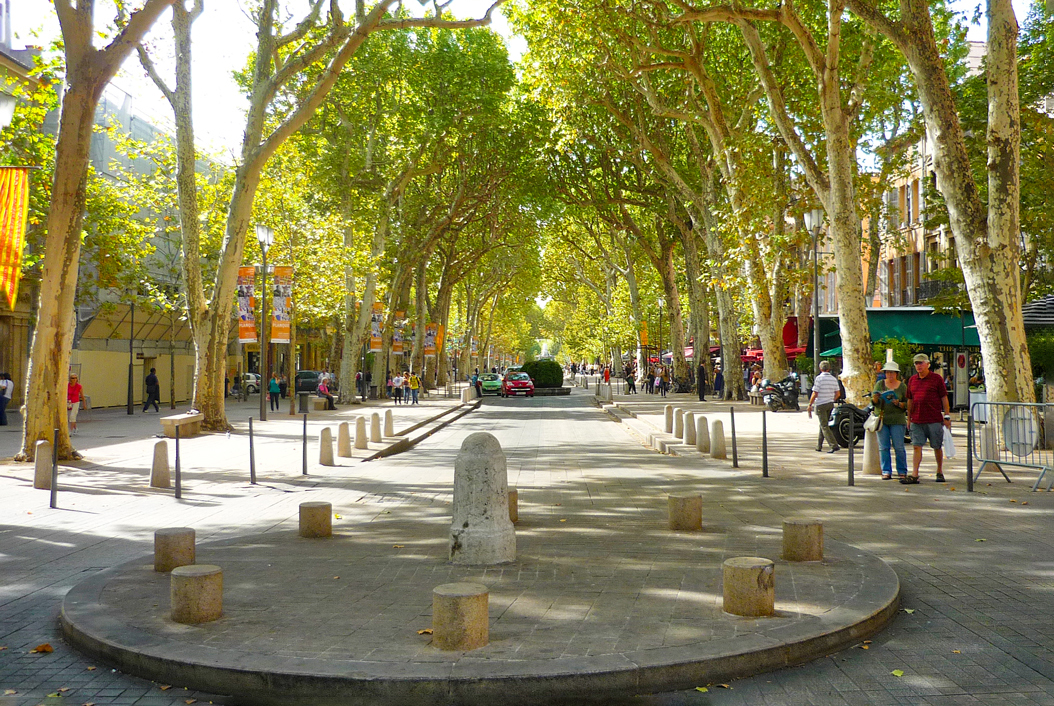
The delightful Place d’Albertas?
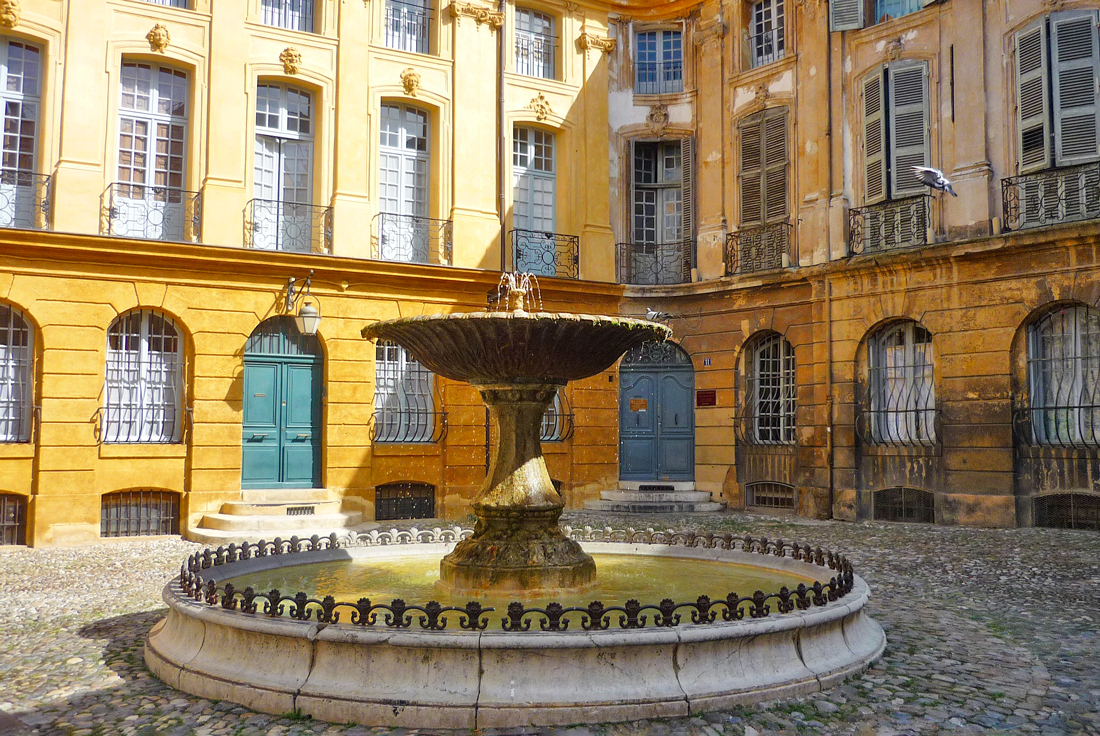
The private mansions of the historic centre?
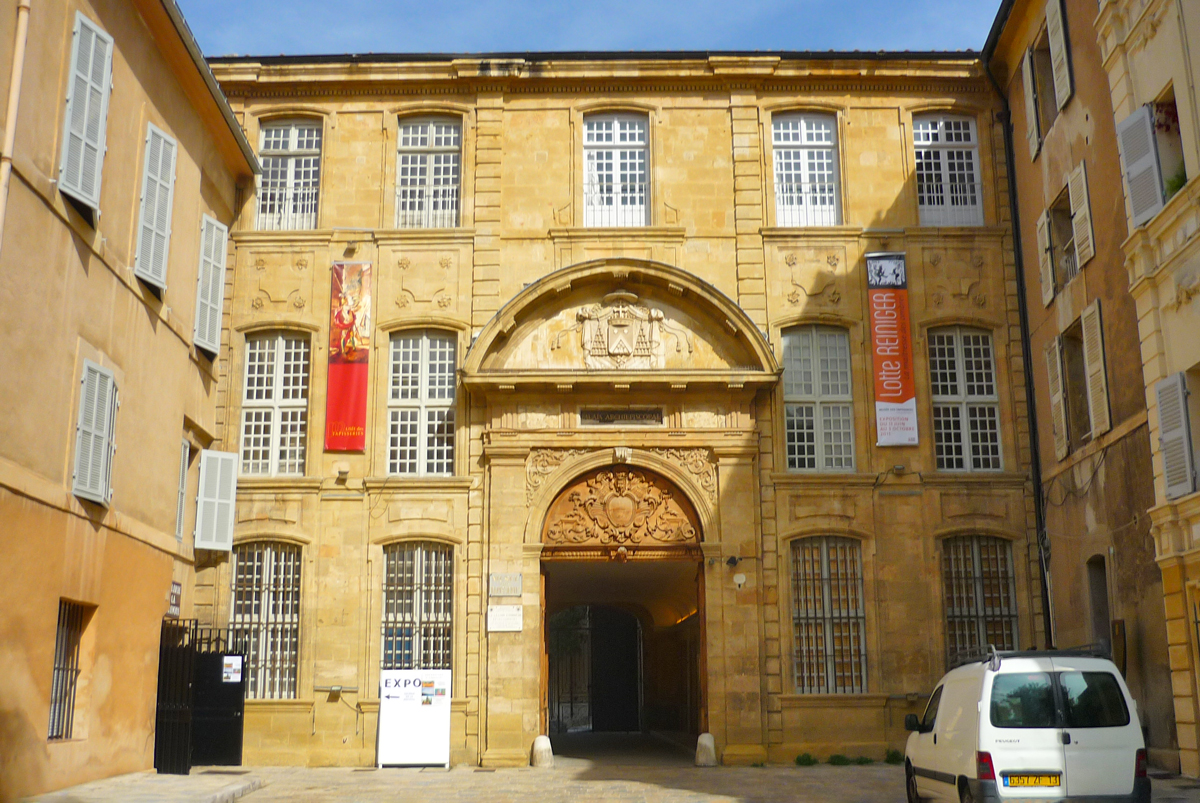
The delicious calissons of Aix?

The memory of Paul Cézanne or Emile Zola?

Aix-en-Provence is all this… and much more!
But for now, let’s leave the city walls to explore its surroundings…
Staying around Aix-en-Provence
You can choose from a great range of accommodation in Aix-en-Provence, from hotels to B&B and campings! My recommendation is to book your accommodation near the city centre. Although it’s a more pricey option, you’ll save time on transportation and can access most of the 10 things to see within walking distance.
Also, when possible, don’t wait until the last minute to book as finding hotel rooms can be a problem, especially on weekdays.
To book your accommodation in Aix, click on this affiliate link which will redirect you to our partner booking.com… or use the interactive map below:
What to see around Aix-en-Provence?
Aix-en-Provence the capital of the Aixois, a part of Provence which is very touristic. To avoid having to write an encyclopaedia on the subject (!), I have voluntarily limited myself to a small selection of 10 destinations within a maximum radius of 30 km.
![Around Aix-en-Provence: La Tour d'Aigues © Yelkrokoyade - licence [CC BY-SA 3.0] from Wikimedia Commons](https://frenchmoments.eu/wp-content/uploads/2022/07/La-Tour-dAigues-©-Yelkrokoyade-licence-CC-BY-SA-3.0-from-Wikimedia-Commons-scaled.jpg)
► Do you have any suggestions for visits to and around Aix-en-Provence? Write them in the comments at the bottom of the article!
Here are the ten main destinations we will discover around Aix-en-Provence:
- Montagne Sainte-Victoire
- Peyrolles-en-Provence
- Pertuis
- La Tour d’Aigues
- Ansouis
- La Roque d’Anthéron
- Lambesc et les sites de La Barben
- Ventabren
- Mimet et la Chaîne de l’Etoile
- Trets
Check the exact location of the 10 places on our Google Map.
To help you, I have included links to the corresponding tourist offices for most of the destinations around Aix-en-Provence. Don’t hesitate to go there to get personal information on natural or cultural sites to discover, hikes to find or the programme of upcoming events.
Let’s start this little trip around Aix-en-Provence with a highly symbolic site close to the city centre: the Sainte-Victoire!
Montagne Sainte-Victoire
Mountainous massif about ten km east of Aix
The Montagne Sainte-Victoire is an emblematic natural landmark of Provence, like other famous peaks such as the Mont Ventoux and the Sainte-Baume. The “Montagne d’Aix” extends over 18 kilometres east of Aix-en-Provence. Reaching 1,011 metres at the Pic des Mouches, the famous mountain owes its fame to the painter Paul Cézanne, who could see it from his home in Aix. The summit of the “Croix de Provence” offers spectacular views of the Sainte-Baume, the Luberon and Etoile ranges, the Durance valley and the Provencal Alps.
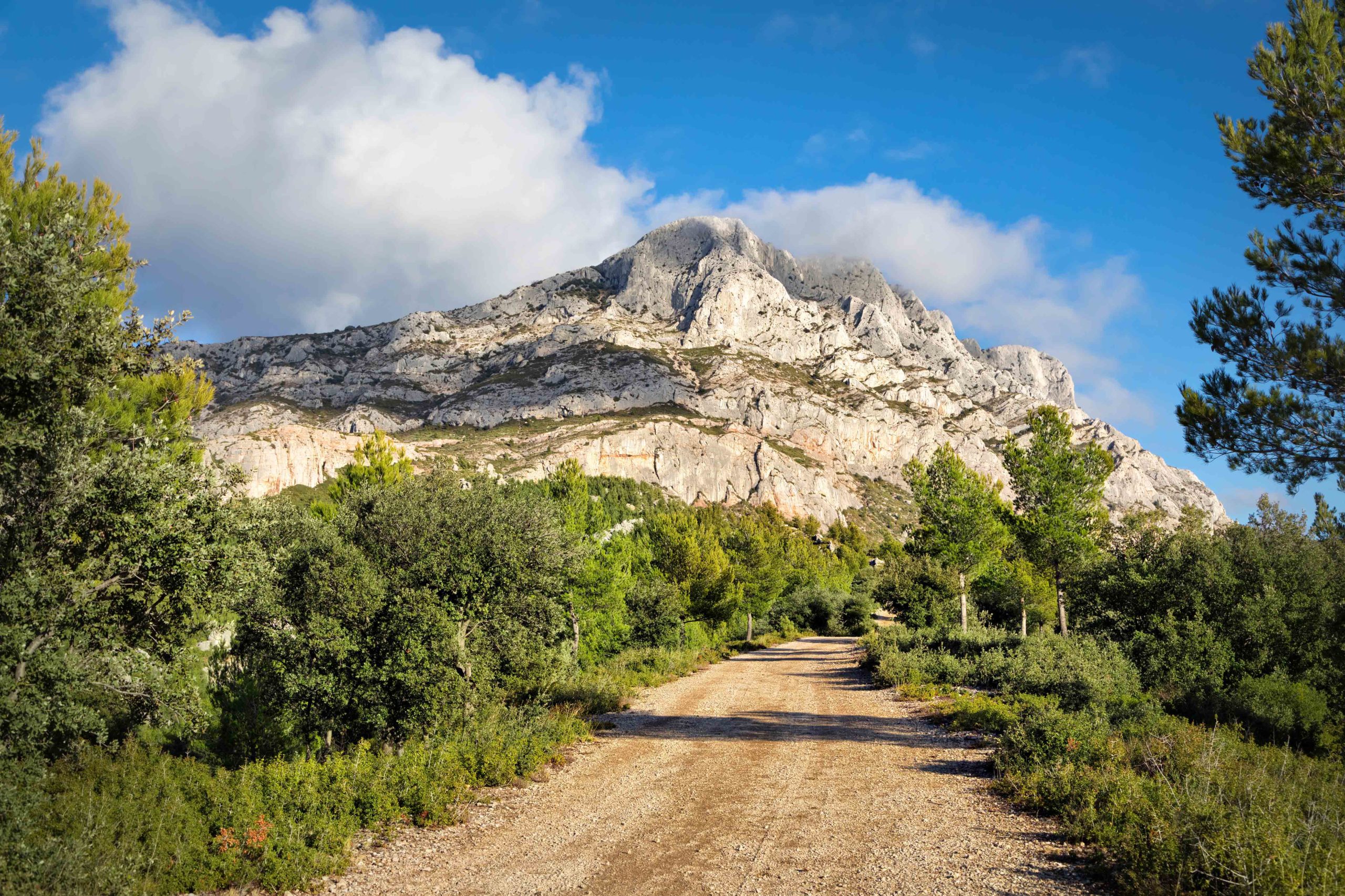
I advise you to drive around the massif from Aix-en-Provence. The 60 km long circuit follows the D17, DD57D, D24, and D10 roads. You will enjoy magnificent views of the Sainte-Victoire. The route passes through picturesque villages such as Le Tholonet, Puyloubier and Vauvenargues, where the painter Picasso is buried.
![Castle of Vauvenargues © Mathieu BROSSAIS - licence [CC BY-SA 4.0] from Wikimedia Commons](https://frenchmoments.eu/wp-content/uploads/2013/06/Château-de-Vauvenargues-©-Mathieu-BROSSAIS-licence-CC-BY-SA-4.0-from-Wikimedia-Commons-scaled.jpg)
Find out more about Montagne Sainte-Victoire on the blog
Tourist Board Website to find out more…
Peyrolles-en-Provence
Village 21 km north of Aix
On the road to Sisteron and Grenoble, Peyrolles-en-Provence is a small village which has preserved its medieval past with a belfry and a wrought-iron bell tower.
![Tour de l'Horloge in Peyrolles-en-Provence © Mathieu BROSSAIS - licence [CC BY-SA 4.0] from Wikimedia Commons](https://frenchmoments.eu/wp-content/uploads/2022/07/Tour-de-lHorloge-Peyrolles-en-Provence-©-Mathieu-BROSSAIS-licence-CC-BY-SA-4.0-from-Wikimedia-Commons-scaled.jpg)
King René’s castle dates from the 17th century and now houses the town hall.
![Around Aix-en-Provence - Peyrolles-en-Provence © Mathieu BROSSAIS - licence [CC BY-SA 4.0] from Wikimedia Commons](https://frenchmoments.eu/wp-content/uploads/2022/07/Peyrolles-en-Provence-©-Mathieu-BROSSAIS-licence-CC-BY-SA-4.0-from-Wikimedia-Commons-scaled.jpg)
The church of Saint-Pierre is of Romanesque origin (12th century) but has undergone several alterations since. The church is adjacent to a ruined round tower.
Don’t miss the unusual chapel of the Holy Sepulchre on its rocky spur overlooking the town. The old sanctuary dates back to the 12th century and has a Greek cross plan. The walls are covered with frescoes depicting the creation of Adam and Eve.
![Around Aix-en-Provence - Peyrolles-en-Provence © Georges Seguin - licence [CC BY-SA 3.0] from Wikimedia Commons](https://frenchmoments.eu/wp-content/uploads/2022/07/Peyrolles-en-Provence-©-Georges-Seguin-licence-CC-BY-SA-3.0-from-Wikimedia-Commons-scaled.jpg)
Tourist Board Website to find out more…
Pertuis
Town 22 km north of Aix
Pertuis is the capital of the Pays d’Aigues, a charming rural area in the heart of Provence, bordering the Durance valley and at the gateway to the Luberon.
To see: the 13th-century clock tower, the 14th-century machicolated Saint-Jacques tower and the 15th-16th century Saint-Nicolas church, which combines Romanesque and Gothic styles.
![Around Aix-en-Provence - Tour Saint-Jacques in Pertuis © Georges Seguin - licence [CC BY-SA 3.0] from Wikimedia Commons](https://frenchmoments.eu/wp-content/uploads/2022/07/Pertuis-Tour-Saint-Jacques-©-Georges-Seguin-licence-CC-BY-SA-3.0-from-Wikimedia-Commons-scaled.jpg)
![Around Aix-en-Provence - Eglise Saint-Nicolas, Pertuis © René Hourdry - licence [CC BY-SA 4.0] from Wikimedia Commons](https://frenchmoments.eu/wp-content/uploads/2022/07/Pertuis-©-René-Hourdry-licence-CC-BY-SA-4.0-from-Wikimedia-Commons-scaled.jpg)
You should stroll through its old streets to discover some of the 130 buildings listed as historical monuments or in the general inventory of cultural heritage.
Tourist Board Website to find out more…
La Tour d’Aigues
Village 29 km north of Aix
La Tour d’Aigues is famous for its castle which houses the Musée des Faïences. The Renaissance-style monument (1555-1575) suffered a fire in 1780 and was ransacked by the Revolutionaries a decade later.
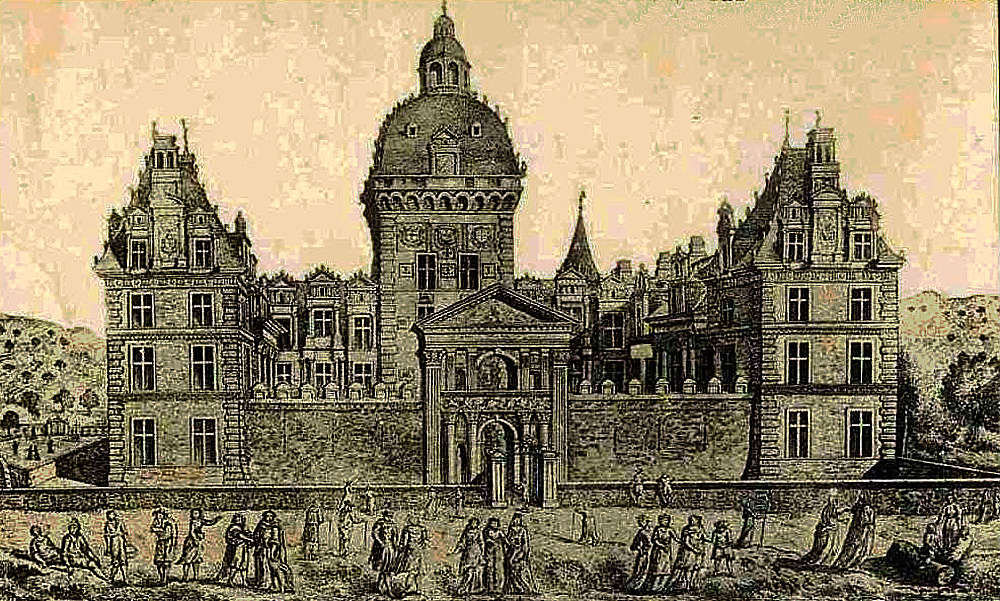
The château de la Tour d’Aigues still looks impressive with its two imposing pavilions framing a monumental entrance gate.
![Around Aix-en-Provence - Castle of La Tour d'Aigues © Véronique PAGNIER - licence [CC BY-SA 3.0] from Wikimedia Commons](https://frenchmoments.eu/wp-content/uploads/2022/07/La-Tour-dAigues-Chateau-©-Véronique-PAGNIER-licence-CC-BY-SA-3.0-from-Wikimedia-Commons-scaled.jpg)
In the village, the church of Notre-Dame de Romégas dates from the 13th to 18th centuries.
![Around Aix-en-Provence - La Tour d'Aigues - Eglise Notre-Dame de Roumegas © Zil - licence [CC BY 3.0] from Wikimedia Commons](https://frenchmoments.eu/wp-content/uploads/2022/07/La-Tour-dAigues-Eglise-Notre-Dame-de-Roumegas-©-Zil-licence-CC-BY-3.0-from-Wikimedia-Commons-scaled.jpg)
Tourist Board Website to find out more…
Ansouis
Village 31 km north of Aix
The perched village of Ansouis is located in the heart of the Pays d’Aigues. It is one of the most beautiful villages in France, renowned for its castle, one of the most beautiful in the Luberon.
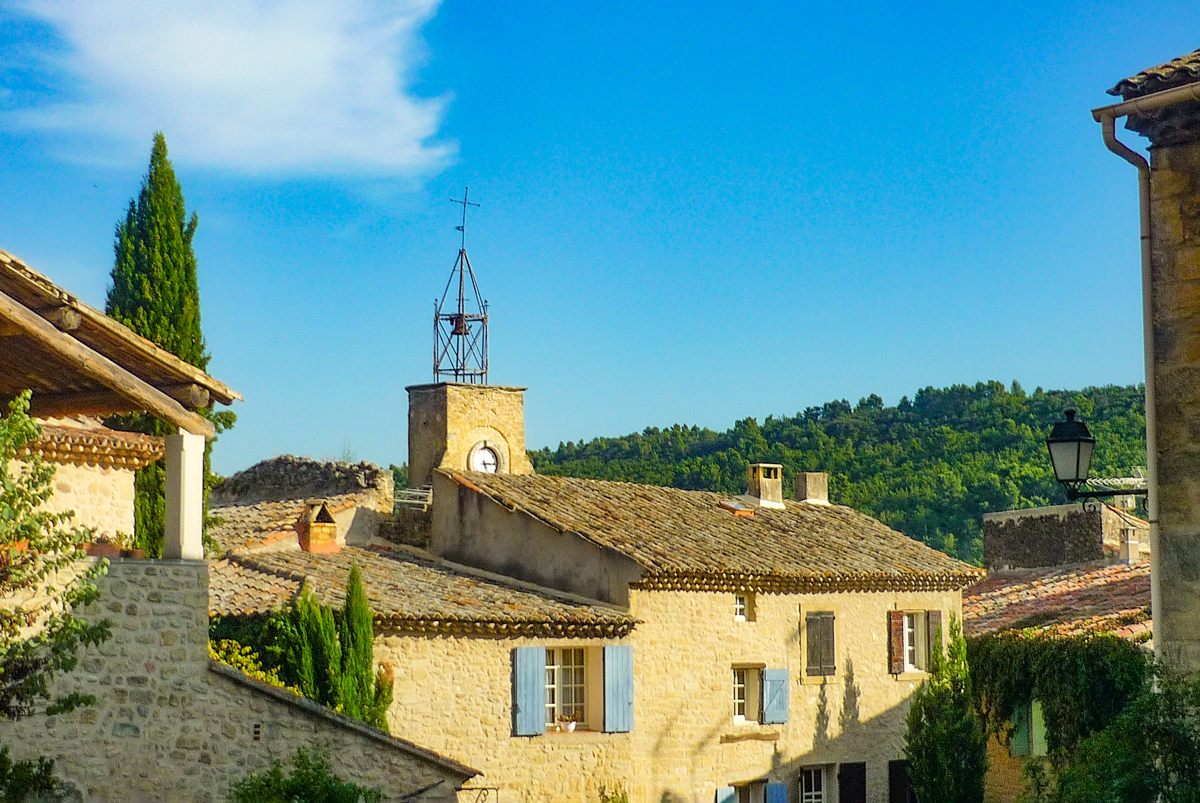
This former residence of the Sabran family was originally a fortress that was modified several times over the centuries to serve as a residence.
The parish church of Saint-Martin dates back to the 13th century and was once attached to the village walls.

It is pleasant to stroll through the shady streets of the village, discovering covered passages. Look up to see the 17th-century belfry with its beautiful wrought iron bell tower.
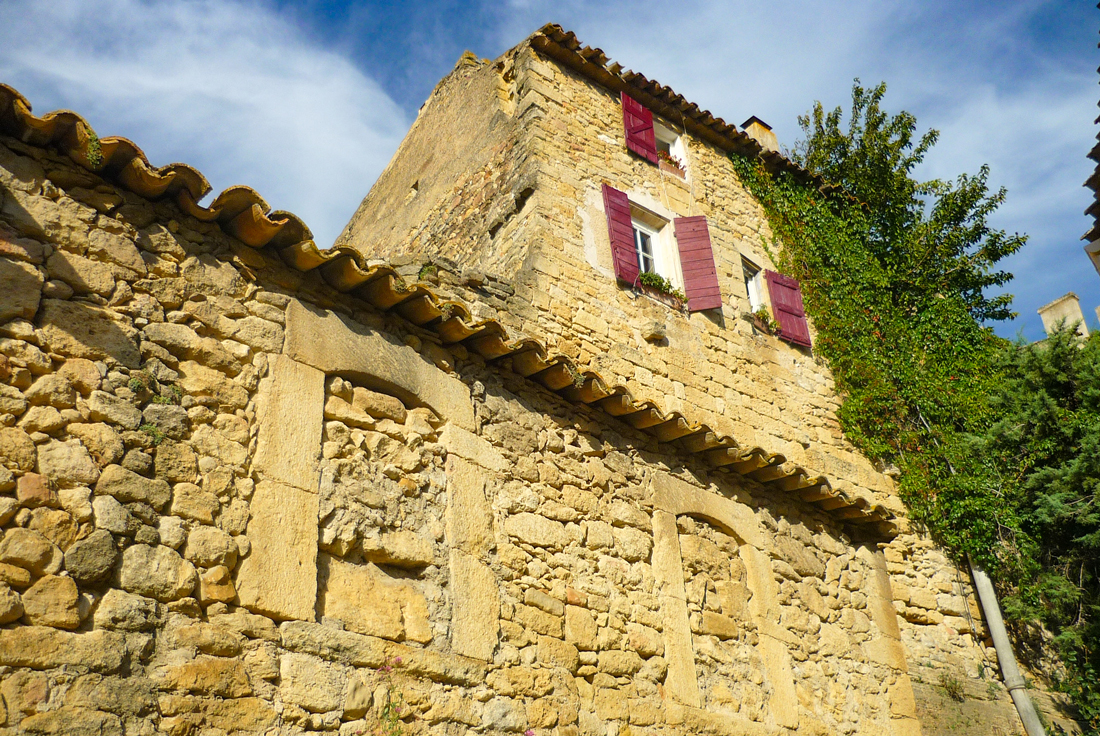
Do you have a little more time and want to go further? Stop off in the tourist village of Cucuron, 5 km from Ansouis!
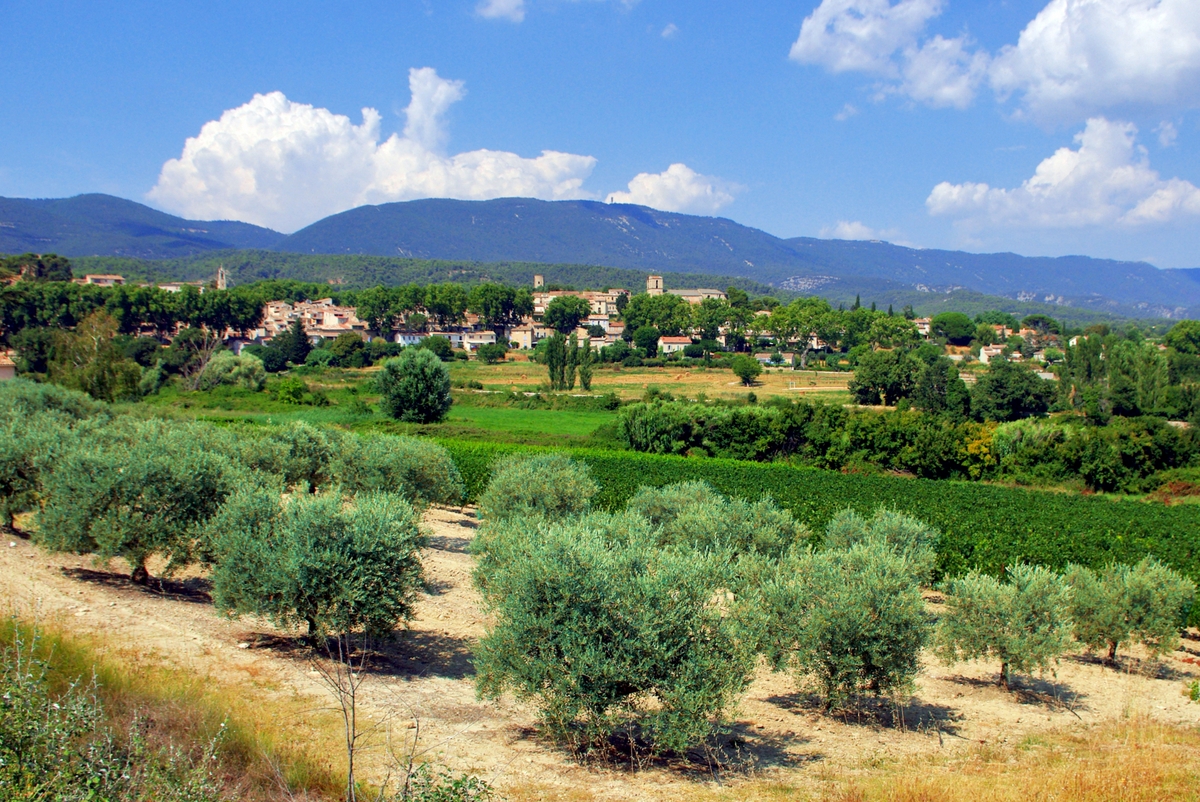
Tourist Board Website to find out more…
La Roque d’Anthéron
Village 29 km north-west of Aix
La Roque d’Anthéron, bathed by the Durance River, is a small village with a Provencal character. In the centre of the village, the 17th-century Château de Florans houses a clinic and its park hosts the prestigious international music festival every year.

But it is certainly the Silvacane Abbey that attracts tourists to La Roque d’Anthéron! It was the monks of Morimond Abbey (in Haute-Marne) who founded the abbey in 1144. Along with Sénanque and Thoronet, Silvacane is one of the three Cistercian abbeys of Provence. These “three Provençal sisters” bear witness to the great influence of the Cistercian order in Provence.
![Around Aix-en-Provence - Silvacane Abbey © [Unknown Author] - licence [CC BY-SA 3.0] from Wikimedia Commons](https://frenchmoments.eu/wp-content/uploads/2022/07/Silvacane-Abbey-©-Unknown-Author-licence-CC-BY-SA-3.0-from-Wikimedia-Commons.jpg)
Tourist Board Website to find out more…
Lambesc and the sites of La Barben
Town, castle and zoo 24 and 26 km west of Aix
On the road from Aix to Avignon, Lambesc has a rich historical and cultural heritage.
Strolling along the streets of the old town centre, you will discover private mansions from the 16th and 17th centuries, fountains built between the 16th and 18th centuries, a 16th-century wash house (rue de la République), as well as a beautiful town gate (Jacquemard tower, 16th century).




To the south of the old town is the picturesque Bertoire windmill. It is one of the few windmills preserved in its original 18th-century state.
![Around Aix-en-Provence - Bertoire Windmill, Lambesc © Mathieu BROSSAIS - licence [CC BY-SA 4.0] from Wikimedia Commons](https://frenchmoments.eu/wp-content/uploads/2022/07/Lambesc-Moulin-de-Bertoire-©-Mathieu-BROSSAIS-licence-CC-BY-SA-4.0-from-Wikimedia-Commons-scaled.jpg)
A few kilometres north of Lambesc, on the Manivert plateau, stands the 11th century Romanesque chapel of Sainte-Anne de Goiron.
8 km southwest of Lambesc is the site of the castle and zoo of La Barben. These are major tourist sites in the Aix-Marseille region.
Tourist Board Website to find out more…
Castle of La Barben
With its resolutely medieval look, La Barben is one of the most impressive castles in Provence.

Its origins date back to the 11th century, but it was remodelled several times in the 16th and 20th centuries. It belonged to the good King René and then to Jean II de Forbin, brother of the famous Palamède de Forbin (known as the Great). The latter was responsible for negotiating the attachment of Provence to France in 1482. It houses the Rocher Mistral, a park on the theme of Provence.
![Around Aix-en-Provence - Château de la Barben © Guillaume Piolle - licence [CC BY 3.0] from Wikimedia Commons](https://frenchmoments.eu/wp-content/uploads/2022/07/Château-de-la-Barben-©-Guillaume-Piolle-licence-CC-BY-3.0-from-Wikimedia-Commons.jpg)
It is assumed that the gardens of the castle are the work of Le Nôtre.
Official Website to find out more…
Parc animalier of La Barben
Nearby, the zoological park of La Barben is home to more than 700 animals of 130 species, including lions, tigers, bears, leopards, wolves, elephants, giraffes, rhinoceroses, hippopotamuses, monkeys, zebras, as well as reptiles in vivaria. La Barben is the closest zoo to Marseille.


Learn more on the blog about La Barben Zoo
Official Website to find out more…
Still a little time to spare? On your way back to Aix, stop in the Provencal village of Rognes!
![Around Aix-en-Provence - Rognes © René Hourdry - licence [CC BY-SA 4.0] from Wikimedia Commons](https://frenchmoments.eu/wp-content/uploads/2022/07/Rognes-©-René-Hourdry-licence-CC-BY-SA-4.0-from-Wikimedia-Commons-scaled.jpg)
Ventabren
Village 16 km west of Aix
Not far from the Etang de Berre, Ventabren is a typical Provencal hilltop village.
![Around Aix-en-Provence - Ventabren © Allie Caulfield - licence [CC BY 2.0] from Wikimedia Commons](https://frenchmoments.eu/wp-content/uploads/2022/07/Ventabren-©-Allie-Caulfield-licence-CC-BY-2.0-from-Wikimedia-Commons.jpg)
The cobbled and flowery streets of the old village are lined with beautiful stone houses that the inhabitants have carefully restored.
The stairways (calades) add to the authentic charm of the site.
![Ventabren © Georges Seguin - licence [CC BY-SA 4.0] from Wikimedia Commons](https://frenchmoments.eu/wp-content/uploads/2022/07/Ventabren-©-Georges-Seguin-licence-CC-BY-SA-4.0-from-Wikimedia-Commons-scaled.jpg)
At the top of the hill, the ruins of Queen Jeanne’s castle dominate the surrounding countryside, offering magnificent views of the Etang de Berre, Vitrolles and the Etoile mountain range.
Tourist Board Website to find out more…
The Roquefavour Aqueduct
Like a Pont du Gard in the Aix region, the Roquefavour aqueduct can boast of being the largest stone structure in the world!
![Around Aix-en-Provence - Roquefavour aqueduct © Allie Caulfield - licence [CC BY 2.0] from Wikimedia Commons](https://frenchmoments.eu/wp-content/uploads/2022/07/Aqueduc-de-Roquefavour-©-Allie-Caulfield-licence-CC-BY-2.0-from-Wikimedia-Commons.jpg)
The aqueduct is the work of a young 26-year-old engineer, Jean François Mayor de Montricher, who built it from 1842 to 1847 to bring water from the Durance to Marseille.
The structure has three rows of arches and is 400 metres long and 83 metres high. In comparison, the Pont du Gard (built 18 centuries earlier) is 266 m long and 47 m high.
Mimet and the Etoile mountain range
Village and natural site 21 km south of Aix
Located in the canton of Gardanne, Mimet has the distinction of being the highest village in the Bouches-du-Rhône département, at an altitude of 491 metres.
![Around Aix-en-Provence © Mimet © Clavida - licence [CC BY-SA 1.0] from Wikimedia Commons](https://frenchmoments.eu/wp-content/uploads/2022/07/Mimet-©-Clavida-licence-CC-BY-SA-1.0-from-Wikimedia-Commons-scaled.jpg)
The old village is home to the church of the Transfiguration-du-Seigneur (12th century but since altered). There is also a 17th-century ice house which supplied the city of Marseille with ice.
The château-bas (lower castle), owned by the Pays d’Aix, is said to have welcomed Charles V when he visited Provence.
Mimet lies on the northern slopes of the Etoile mountain range, which faces the long rocky bar of the Sainte-Victoire mountain.
The territory of the commune includes the summits of the Etoile range with access by the Col Sainte-Anne trail. The hikes can continue along the ridge line in the territory of the commune of Saint-Savournin with breathtaking views of :
- to the north, the Sainte-Victoire mountain, the Mont Ventoux and the Montagne de Lure
- to the south, Marseille, the Frioul islands and the Mediterranean Sea.
![Around Aix-en-Provence - Grand Puech © Fr.Latreille - licence [CC BY-SA 3.0] from Wikimedia Commons](https://frenchmoments.eu/wp-content/uploads/2022/07/Grand-Puech-Sainte-Victoire-©-Fr.Latreille-licence-CC-BY-SA-3.0-from-Wikimedia-Commons.jpg)
![Around Aix-en-Provence - Grand Puech © Fr.Latreille - licence [CC BY-SA 3.0] from Wikimedia Commons](https://frenchmoments.eu/wp-content/uploads/2022/07/Grand-Puech-Marseille-©-Fr.Latreille-licence-CC-BY-SA-3.0-from-Wikimedia-Commons.jpg)
Tourist Board Website to find out more…
Trets
Town 24 km east of Aix
As its name suggests, Trets means “Three” or “Trois”, in the image of its coat of arms representing three three-lobed clovers. This plant, formerly used to cure diseases of the liver, grows in abundance around the Hermitage of Saint-Jean-du-Puy.
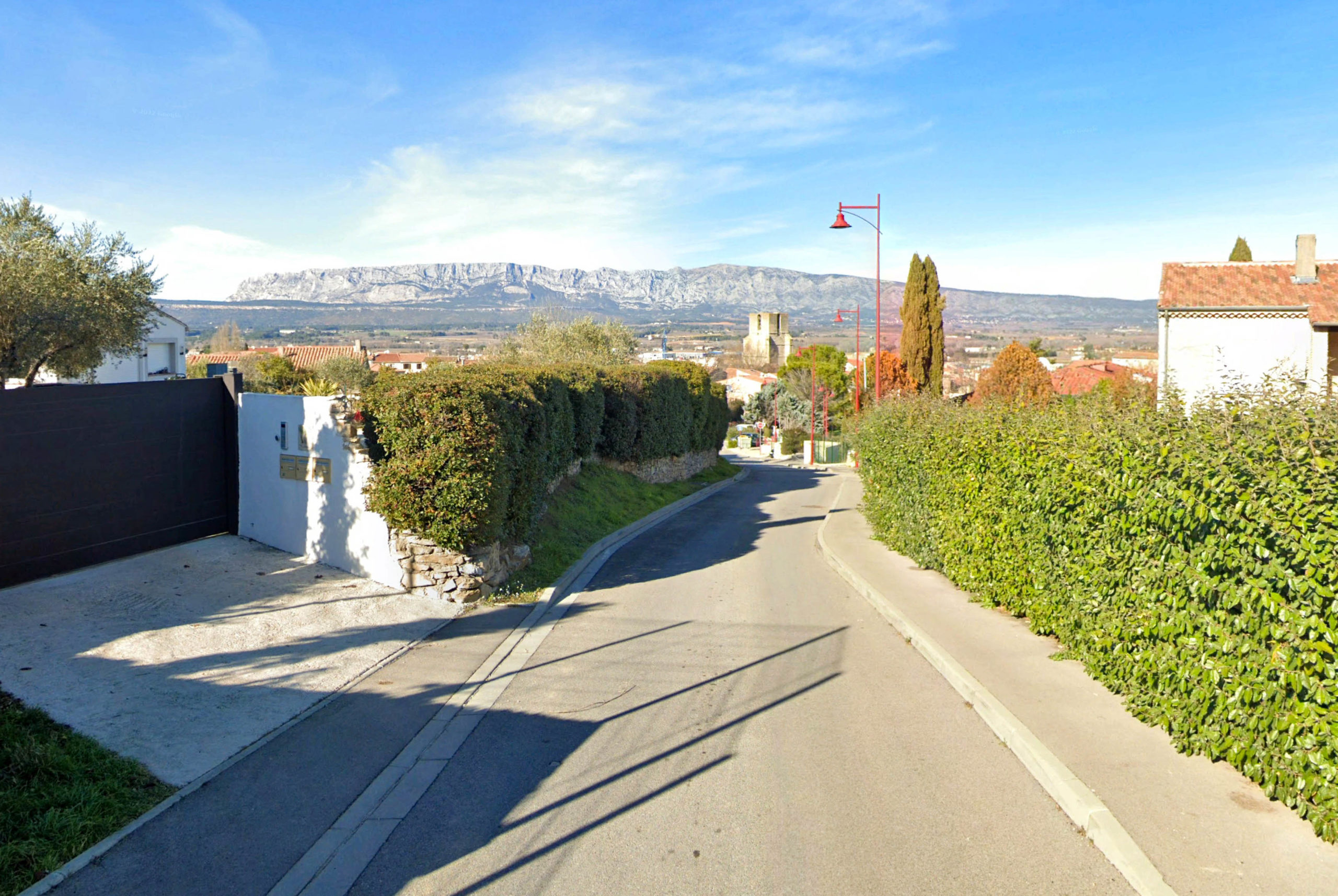
The old medieval centre was surrounded by ramparts, which have now been replaced by the Avenue Mirabeau, the Boulevard Boyer and the Boulevard Vauban. Two city gates remain: the Porte de Pourrières and the Porte de Saint-Jean.
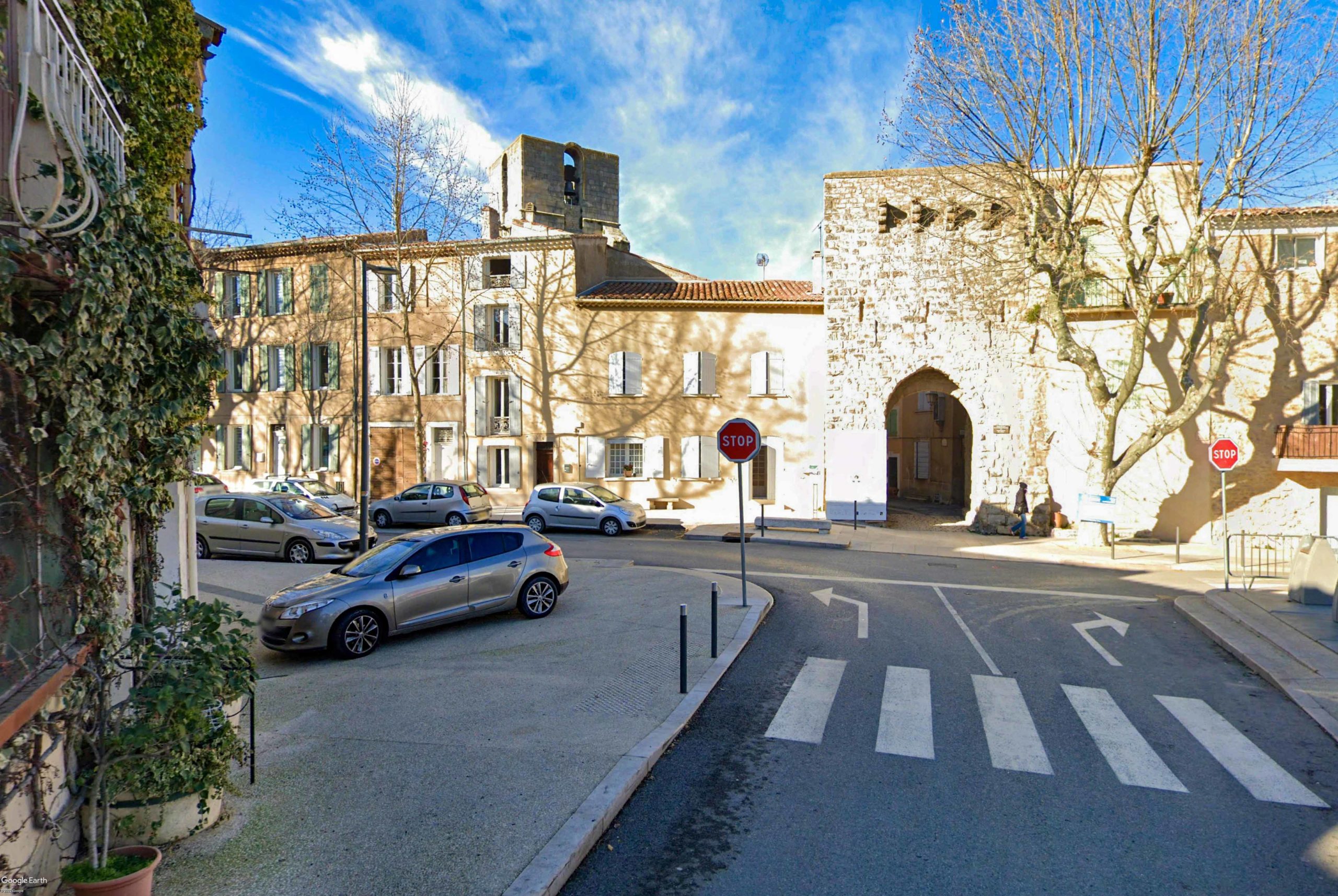
In the centre of the village, the Place Pailheret is the former market square of Trets. It is bordered by a corbelled house.
Strolling through the narrow streets, you will discover other houses built on arches thrown over the streets. These vaulted passages can be seen in rue Veyrier, rue Félix Pyat and rue Grande Pujade.
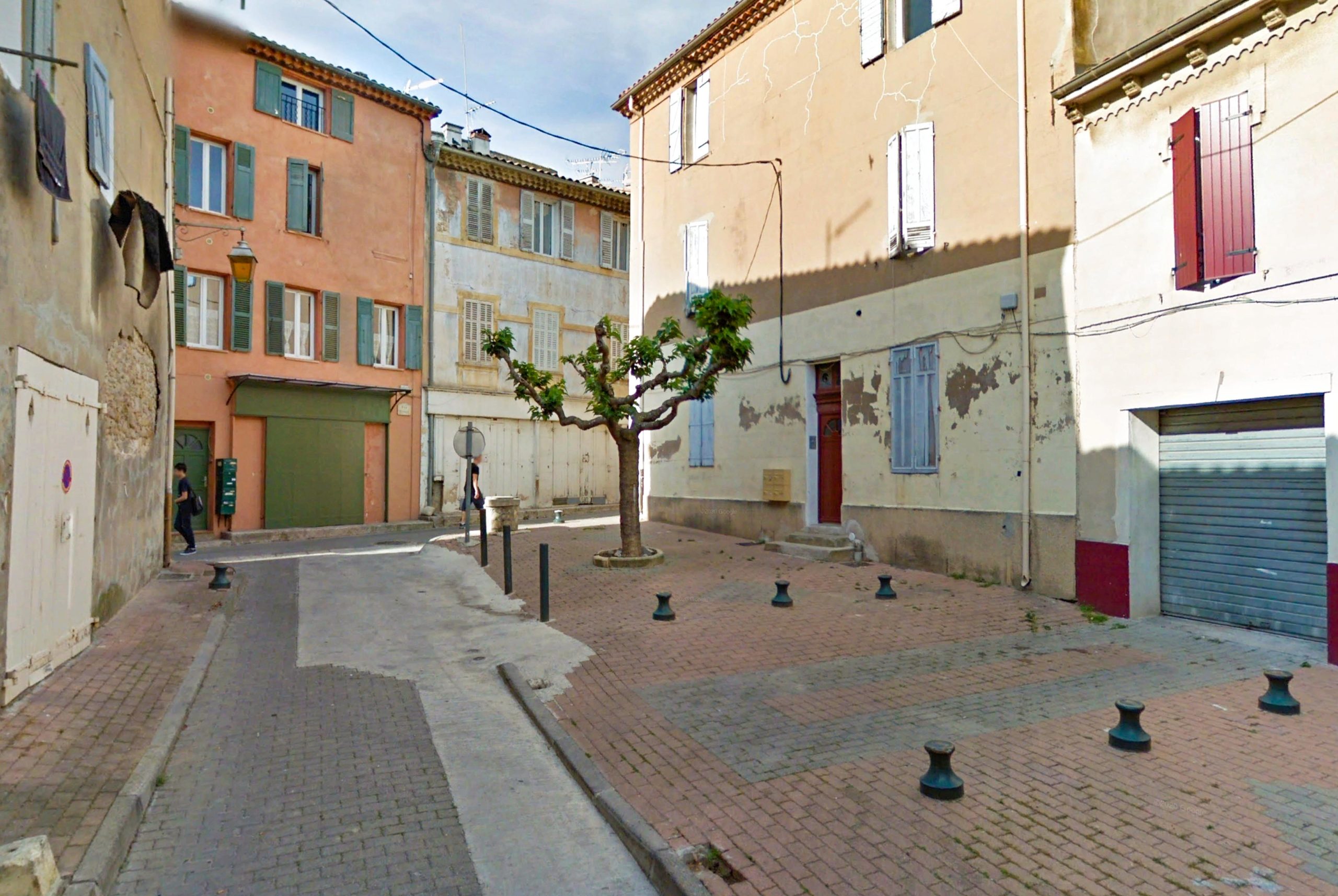
The parish church of Notre-Dame-de-Nazareth dates back to the 11th or 12th century. It has a Romanesque nave and a curious polygonal chevet decorated with a Lombard frieze. Admire the high altar made of polychrome marble.
The feudal castle (château des Remparts) probably dates from the early 13th century. It still has machicolations and loopholes. The interior is decorated with painted ceilings and a baroque fireplace.
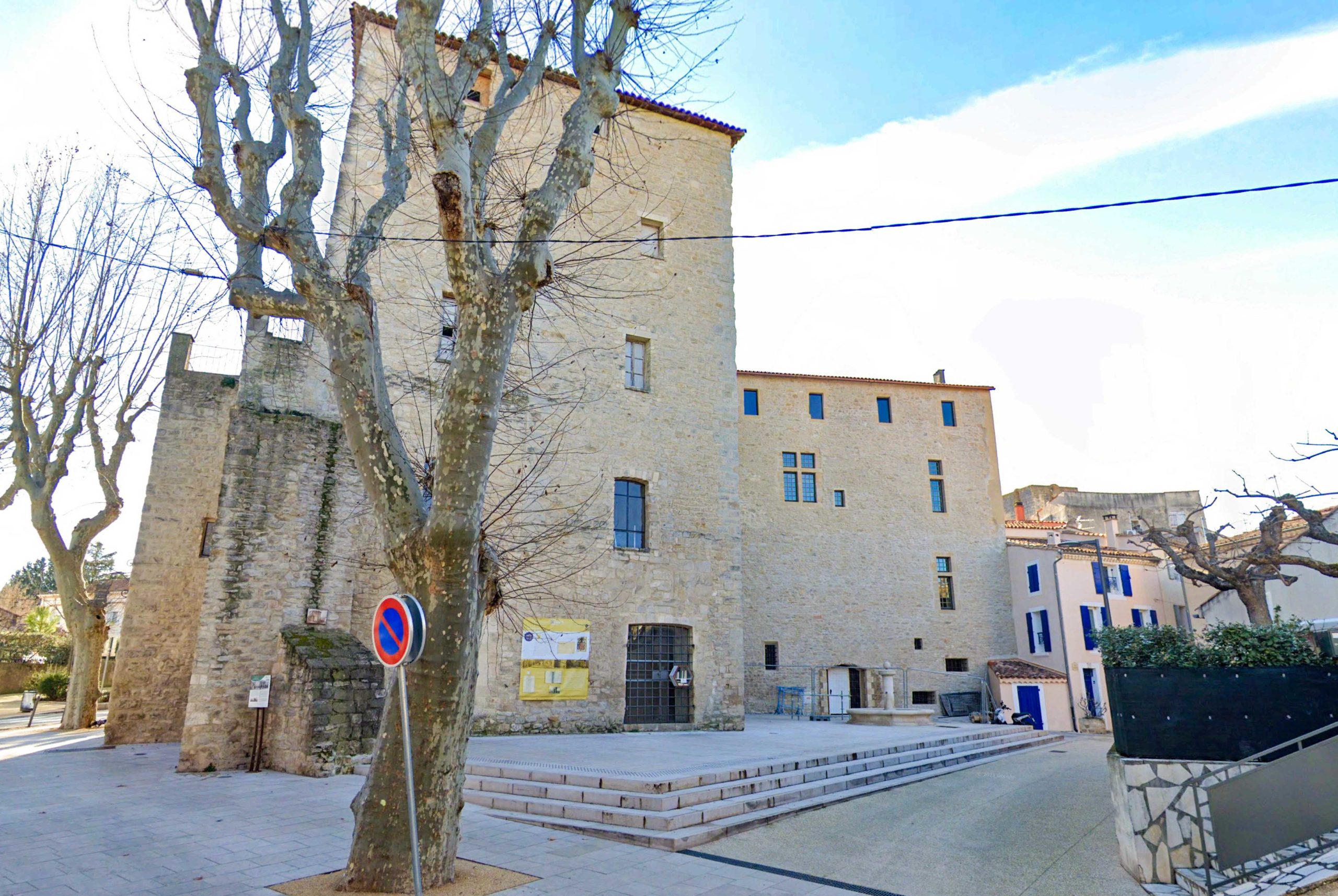
Tourist Board Website to find out more…
Saint-Jean-du-Puy
The village is situated at the foot of the Regagnas mountain range, which includes Mount Olympe and Mount Aurelien.
![Mont Olympe © Henri Michelon - licence [CC BY-SA 3.0] from Wikimedia Commons](https://frenchmoments.eu/wp-content/uploads/2022/07/Mont-Olympe-©-Henri-Michelin-licence-CC-BY-SA-3.0-from-Wikimedia-Commons.jpg)
Ten kilometres from the town centre, the D12 road climbs to the Hermitage of Saint-Jean-du-Puy, which rises to 658 metres. Local tradition attributes its foundation to Saint Jean Cassien in 412.
In the Middle Ages, the priory belonged to the abbey of Saint-Victor de Marseille. At the top of the hill stands a bell tower that looks like a watchtower. There is a magnificent view of two emblematic mountains of Provence: Sainte-Victoire and Sainte-Baume.
Marseille
City 33 km south of Aix
It would be difficult to close this article on destinations around 30 km of Aix-en-Provence without mentioning… Marseille! Even if it is true that we are exceeding our distance rule by three small kilometres!
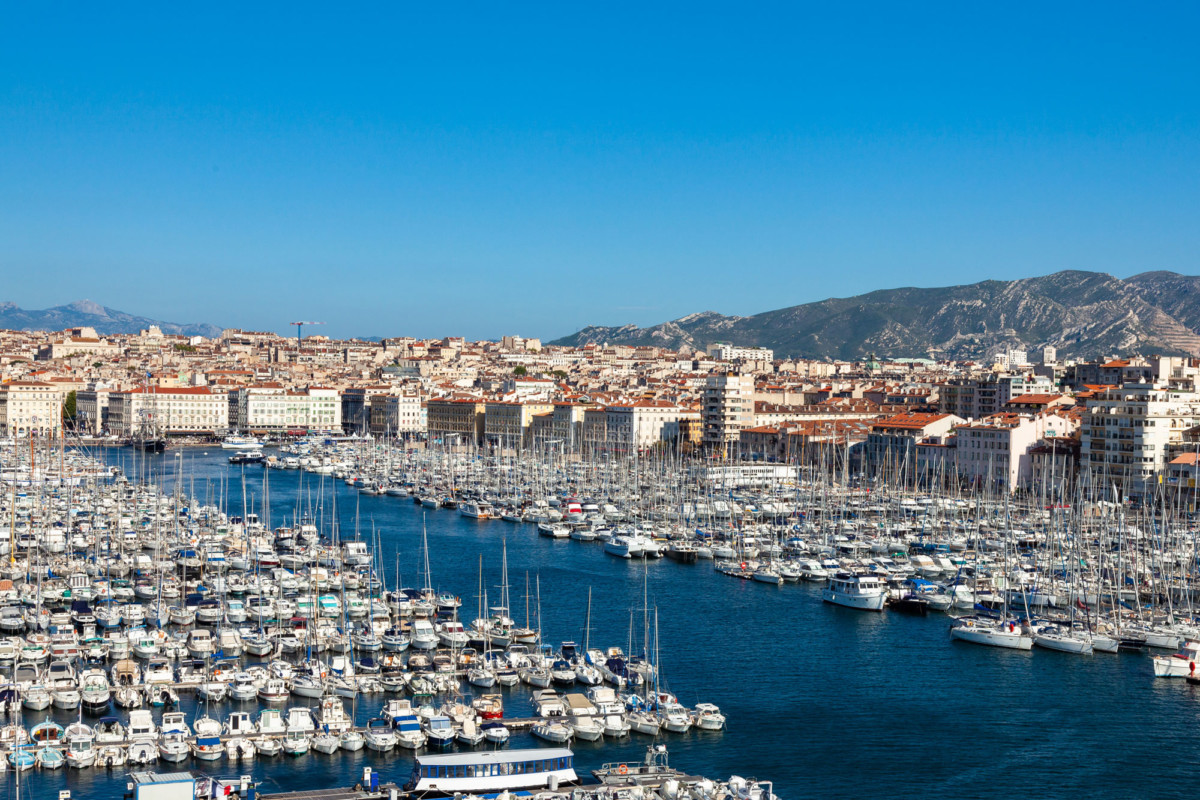
A 2600-year-old Greek and Roman city, Marseille is like a magnet. Its Vieux-Port, its Notre-Dame-de-la-Garde basilica, its Canebière, its Panier district… it is certain that France’s third-largest city will never leave you indifferent.
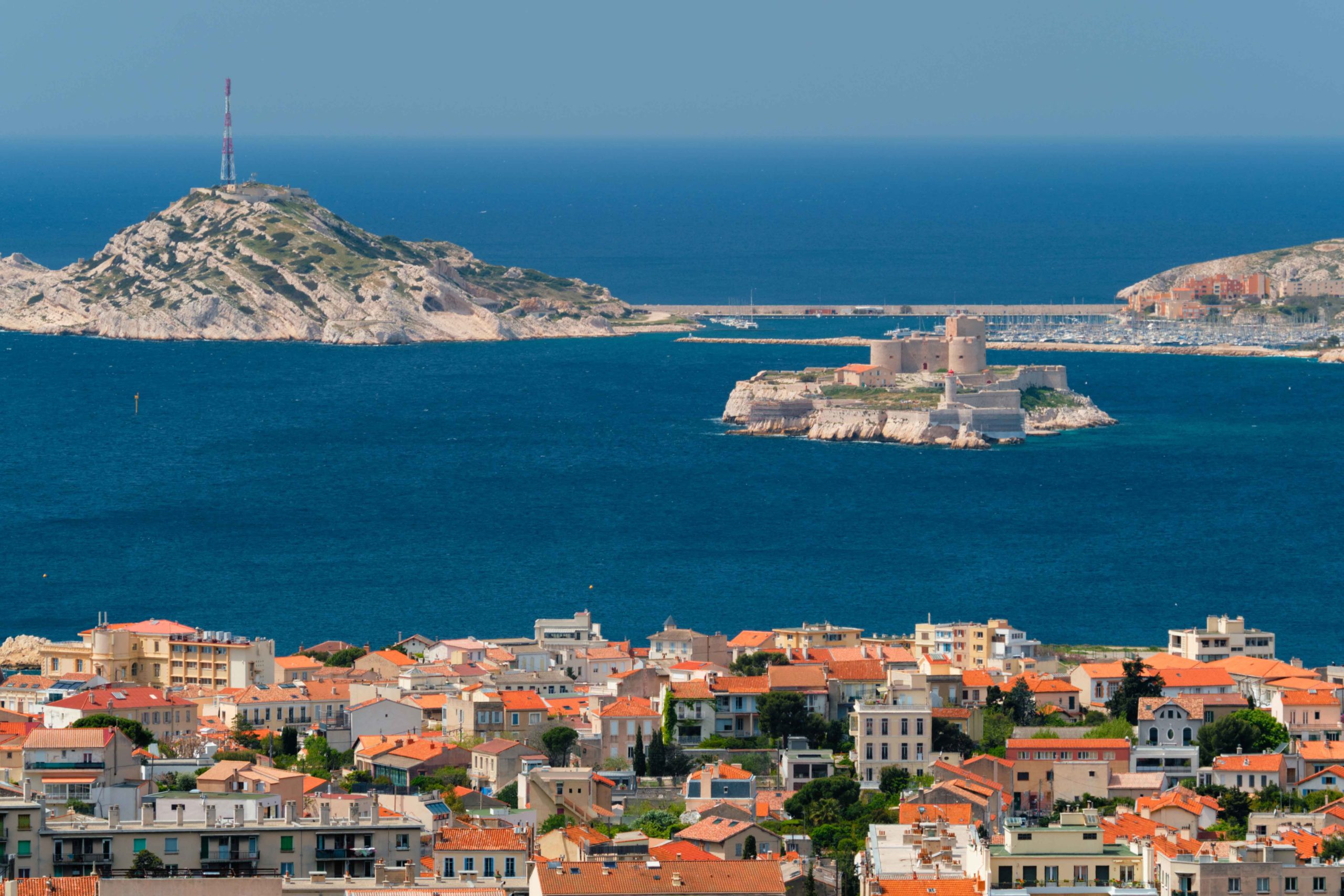
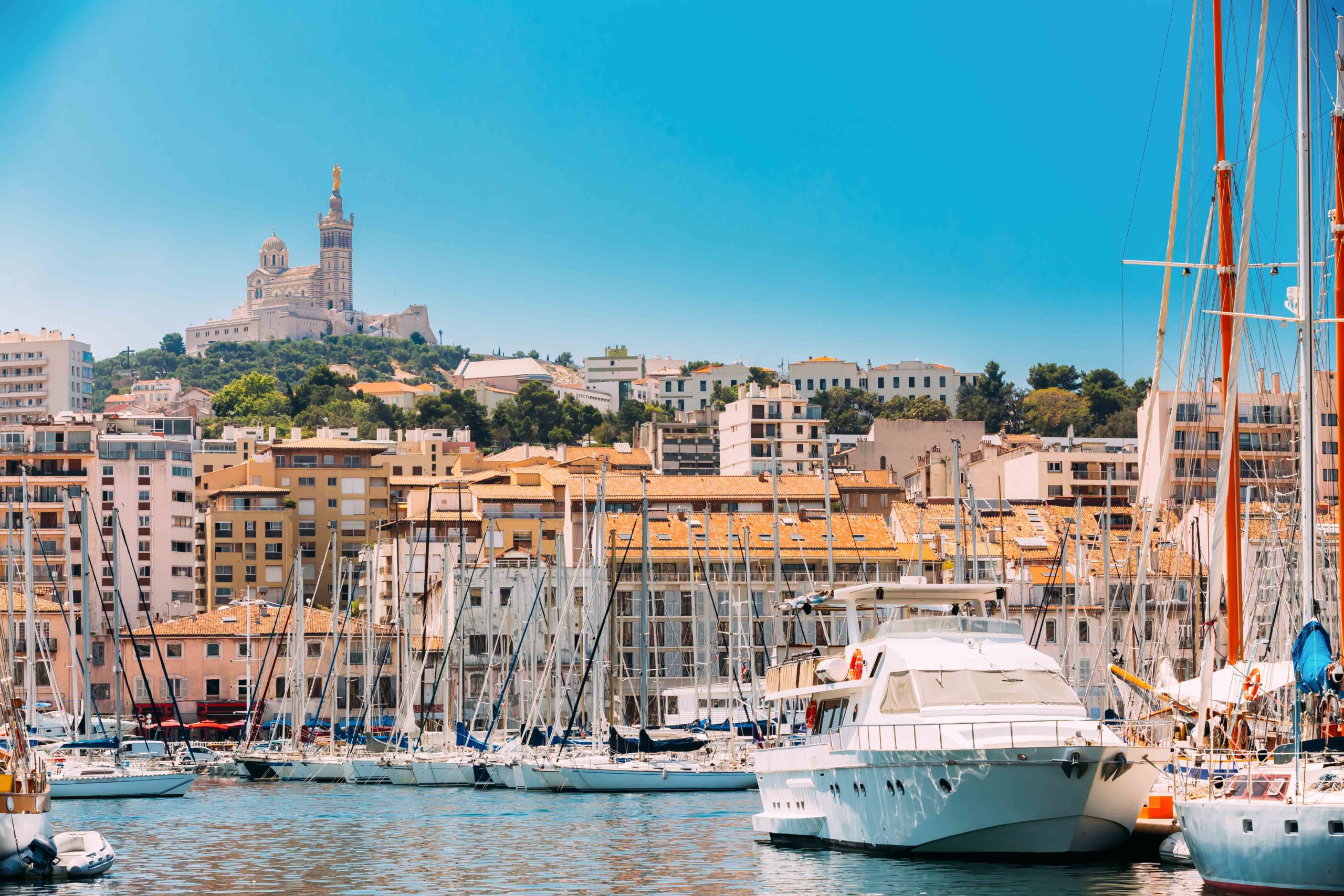
Tourist Board Website to find out more…
Practical information
Some practical advice to discover the sites around Aix-en-Provence:
- You can avoid the traffic jams to and from Aix-en-Provence by driving outside of rush hour, especially if you use the motorways and expressways that border the city to the west and south.
- These 10 places inspire you to discover the region around Aix-en-Provence (less than 30 km by road). Let yourself be surprised by other discoveries during your escapades, and stay curious! There is so much to discover, especially if you are a lover of small heritage.
- Don’t hesitate to enter the tourist office centres. During my French travels, the receptionists I met know the area and will be happy to help you discover their beautiful region.
- Click here to get ideas about accommodation in the area around Aix-en-Provence
- Visiting the region around Aix-en-Provence? Think of the following hashtags: #provenceaixperience – #visitsouthoffrance – #enfranceaussi – #frenchmoments
![May Poppies in Sainte-Victoire © Paul Oublon - licence [CC BY-SA 4.0] from Wikimedia Commons](https://frenchmoments.eu/wp-content/uploads/2013/06/May-Poppies-in-Sainte-Victoire-©-Paul-Oublon-licence-CC-BY-SA-4.0-from-Wikimedia-Commons-scaled.jpg)
Other blog posts that might interest you
All our pages about Aix-en-Provence on the blog:
- Practical info for planning your visit to Aix-en-Provence
- Aix-en-Provence Old Town: A Discovery Guide
- Aix-en-Provence Cathedral: A Discovery Guide
- Place de l’Hôtel de Ville of Aix-en-Provence
- Place d’Albertas: an elegant square in Aix-en-Provence
- The Calissons of Aix: a Specialty Candy from Provence
- Montagne Sainte-Victoire: the iconic mountain of Aix
- Aix-en-Provence History: A Brief Account
- Discover the historic and cultural region of Provence on the blog
More info about Aix-en-Provence:
- Read this article in French on our blog Mon Grand-Est
- Visit the Tourist office board of Aix-en-Provence
- Read more about Aix-en-Provence old town on Wikipedia
- Book your accommodation in Aix-en-Provence
🚙 Rent a car in Aix-en-Provence
Things to do in and around Aix-en-Provence
Looking for activities and things to do in and around Aix-en-Provence? Check out the offers from our partner Get Your Guide:
Pin it for later
Liked what you read about what to see around Aix-en-Provence? If so, please pin it on Pinterest:
